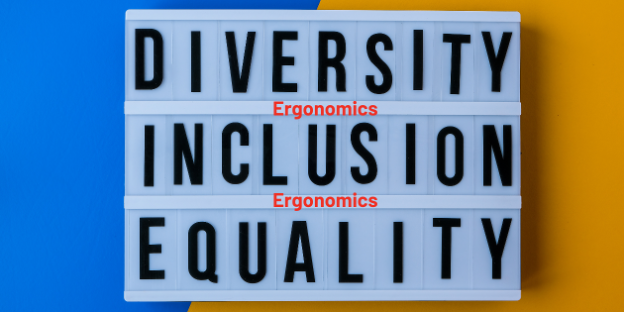
A diverse and inclusive workplace is one that makes everyone, regardless of who they are or what they do for the business, feel equally involved in and supported in all areas of the workplace.
The “all areas” part is important. Integrating the science of Ergonomics into your organization’s Diversity and Inclusion plan is a great way to enhance the outcomes of equality.
Employees need to feel free to express themselves based on their unique perspectives. Companies must make sure employees feel included and respected regardless of their:
- Age,
- Gender,
- Race,
- Religion,
- Sexual orientation,
- Physical conditions,
- Cultural background or
- Country of origin.
How can ergonomics enhance diversity and inclusion?
It is simple. Ergonomics is the science of fitting the work environment to the human. When you use the science of ergonomics to understand how people work to their maximum performance, you will naturally make work more inclusive while accepting the diversity of each person. In turn, employees will achieve better results and better health.
Ergonomics is simply human-centered design, and it focuses on performance and well-being by recognizing the unique differences of people to make work more universal. Here are a few examples where ergonomics helps with diversity and inclusion.
Example #1:
An employer recently purchased one size fits all chairs for a workforce of 2000 employees. After installation, the employer began to receive many complaints from the employees using the chairs. On further review, they learned that these chairs did not support at least 20% of their population because the chairs did not support petite or large occupant individuals. Employees began to have discomfort and many filed claims because of the employer not creating a chair standards program that addressed the needs of all individuals in the workplace as well as the diversity of sitting work styles requiring more adjustable chairs for different types of work.
The culprit came down to the real estate division, responsible for purchasing chairs, did not understand the diversity of their workforce and how it relates to the ergonomics of sitting, chair assessment, selection and fit. A costly mistake that could have been avoided with education regarding awareness of human size as it relates to the science of sitting, and work performance as it relates to diversity and inclusion.
Example #2:
An employer decided to get on board with the sit to stand (s2s) revolution by purchasing at least 30 desk converters for their administrative staff. Once placed on the surface, the employees did not use them like the employer thought they would. On further investigation, the employer noticed employees were not standing or using the devices. Employees began to complain about the desk converters causing pain and discomfort. An ergonomist evaluated the employee concerns and revealed to the employer, in their effort to help employees, they failed to consider the impact these devices have on their diverse workforce. The desk converters were ineffective and presented a high risk of injury for petite individuals with shorter sitting heights, employees with pre-existing back pain who are unable to manually lift the desk converter weighted with monitors and other equipment; employees with vision changes who require bifocals aggravating their neck from elevated monitor positions, and weaker, older employees who didn’t have the strength to lift the manual surfaces from desk height to shoulder height.
The culprit came down to the management team not being well versed in the pros and cons of s2s desk converters on a diverse workforce. To be more inclusive, provide these individuals with electric sit to stand desks that move in a range acceptable to petite to tall individuals and does not require significant strength capacity to activate.
As you seek to improve your Diversity and Inclusion program, your ergonomics program plays an especially important role in making everyone, regardless of who they are or what they do for the business, feel equally involved in, capable, and supported in all areas of the workplace. Do not leave ergonomics out of the diversity, inclusion, and equality equation. If you do, you will pay the price of not meeting the needs of many employees creating increased costs and risk to your organization.
At Worksite International, we help companies support a diverse, inclusive workforce everyday using the science of ergonomics. To learn more, contact us directly for a consultation on how we can help your organization.

Comments